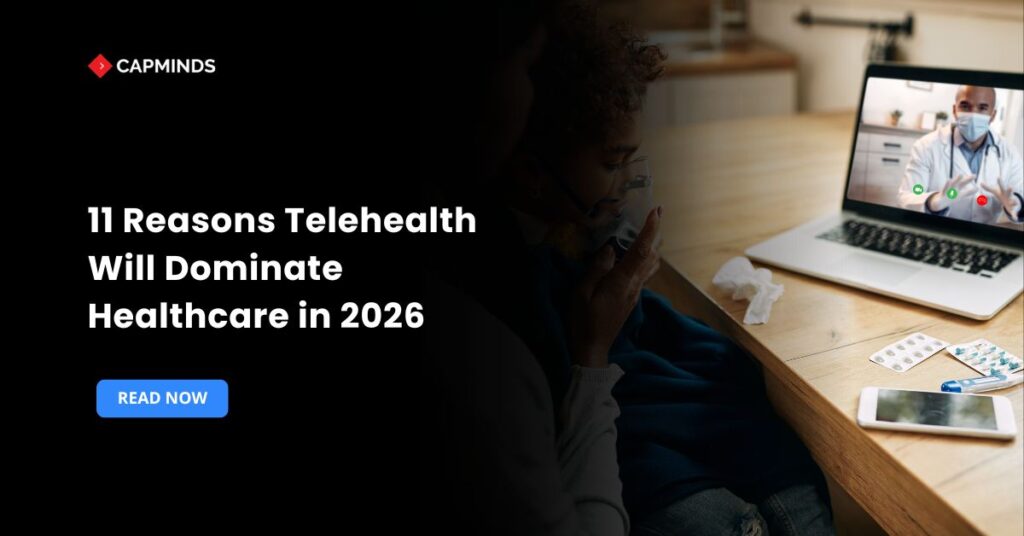11 Reasons Telehealth Will Dominate Healthcare in 2026
Telehealth, digital and telecommunication technologies applied in care delivery, has been transformed and is a part of modern medical practice. It covers virtual consultations to AI-based diagnostics and makes healthcare more accessible and patient-centered.
The telemedicine market in the world is estimated to be about 194.07 billion by the year 2026, where half of all the doctor visits in developed countries are projected to be virtual.
The Rise of Virtual Care in 2026
Virtual care has reshaped access to healthcare by transforming patients into a need during the pandemic into a preference. Adoption has been driven by regulatory support, expanded insurance coverage, and better quality of service.
New models in healthcare systems are now adopting the hybrid approach of combining physical and virtual visits to address the changing expectations of patients and provide quicker and patient-centered care.
Key Technological Drivers Behind Telehealth Growth
Telehealth is being revolutionized by the impact of technological innovations such as 5G connectivity, AI Integration, and Remote Patient Monitoring.
Cloud systems make data management easier and improve clinical and security features, as cloud systems drive scalability, integration, and EHR security.
Remote care is becoming a dependable, efficient, and holistic healthcare solution that is being facilitated by these innovations.
Benefits of Telehealth in Healthcare 2026
1. Incomparable Access and Convenience to Patients
Telehealth breaks the geographical boundaries and significantly increases patient access to care, particularly in the underserved and rural areas.
As an example, a patient in a distant location can meet a specialist hundreds of miles away within seconds, and this will greatly cut the amount of time waiting in line, which has been the same with specialty care.
2. Improved Chronic Condition Management through RPM
Chronic disease management is being transformed by remote patient monitoring systems. Connected biometric sensors, which include smart scales, continuous glucose monitors, and blood pressure cuffs, use wearable devices to feed data into providers in real time.
This will enable an intervention before a minor problem develops into a crisis. Clinical and economic value of RPM is demonstrated in the real world, with conditions such as congestive heart failure and diabetes, severe cuts in hospital readmission rates due to RPM.
3. Artificial Intelligence Diagnostics and Triage
Diagnostic accuracy and efficiency are being enhanced by the implementation of AI in a telehealth platform. The algorithms that run on AI may show preliminary diagnoses or prioritize the urgent cases based on patient-reported symptoms, EHR-based medical history, and even images.
AI-based solutions in teledermatology may help to screen skin damage with a high level of accuracy to allow the healthcare provider to spend their time on complicated cases that may need human care.
4. Major Decrease in Healthcare Expenses
Telehealth in healthcare saves overhead expenses for providers and costs to patients through switching routine check-ups and visits to virtual platforms. Less clinical space and administrative staff are spent, and fewer non-urgent emergency room visits occur.
Payers are increasingly endorsing virtual care through good reimbursement policies, and the financial argument is now established to support its dominance in the long term.
5. Cloud-Based Telehealth Solutions: Scalability
The secure and scalable cloud-based telehealth solutions migration is the basis of massive adoption of virtual care. Through these platforms, healthcare organizations can easily spread their virtual services without incurring huge capital investments in the physical infrastructure.
Cloud technology allows the seamless integration of new tools, human AIs, chatbots, and new patient engagement tools, as well as makes data accessible and secure, which leads to uninterrupted growth and innovation.
Related: The Ultimate Guide to Building a Unified Patient Record Strategy with EHR, Telehealth, & RPM
6. Finding a Solution to the Mental Health Crisis
The adoption of virtual care via tele-psychiatry and tele-therapy has experienced some of the greatest and most consistent rates. Virtual mental health appointments make more patients seek help as they are convenient and perceived to be anonymous.
Such access becomes essential in a global environment where there is an acute shortage of specialists in the field of behavioral health, and this is the way in which telehealth in healthcare can provide much-needed specialty care.
7. Patient Feedback and Satisfaction
The latest telehealth systems propose advanced patient engagement systems, which include necessary facilities such as secure messaging, customized educational material, and online check-in forms that ensure patients remain actively engaged in their care process.
Virtual visits have consistently reported high scores in patient satisfaction, despite the decreased waiting time and the comfort of having the care delivered at home, which contribute to a higher long-term usage and retention rate.
8. Improved Data and Individualized Medicine
All virtual communication, data points of an RPM device, and AI-based analysis result in a huge amount of evidence in the real world. This information allows the providers to proceed to actual individualized medicine.
Through a study of trends within a group of patients, the digital transformation of the health system provides a more accurate risk group and the development of highly individualized treatment plans, transforming medicine into a predictive process rather than a reactionary one.
9. Expedited Provider Clinical Processes
Telemedicine sites are becoming more tied to EHRs and are automated to provide administrative functions such as scheduling, charting, and billing.
Such efficiency liberates clinical employees to work on patients, leaving the administrative workload that causes physician burnout behind. The work-life balance and flexibility of the providers are also provided by the ability to make virtual visits regardless of where they are located.
10. Clarity of Regulatory and Reimbursement
Government payers and regulatory bodies are offering long-term assurance on the issue of telehealth reimbursement, overcoming one of the biggest challenges that had previously slowed down its adoption.
Continuous debates and suggested permanent regulations guarantee that providers can receive fair compensation for virtual services, a required action to achieve sustainable implementation of telehealth in healthcare, and a further step of digital health transformation.
11. International Focus and International Cooperation
Telehealth is not bound by any national or regional borders, making it easy to consult with the best experts in the world regarding a new opinion or to review more complicated cases.
Worldwide access to knowledge is not only a blessing to the patient, but also to medical research and medical training, where best practices and intercontinental care can be spread through secure telemedicine networks in the shortest time possible.
Transform Virtual Care with CapMinds Telehealth Services
As telehealth continues to redefine the future of healthcare delivery, your organization needs a trusted digital health partner to stay ahead.
CapMinds empowers healthcare providers with advanced, scalable, and compliant solutions designed to enhance care accessibility and operational efficiency.
Our Telehealth Services are built to deliver seamless virtual care experiences from AI-driven consultations to secure patient engagement tools. Together with our Patient Portal and Healthcare IT Services, we enable a fully connected and patient-centric ecosystem.
Here’s what we offer:
- End-to-End Telehealth Solutions – Secure video consultations, remote monitoring, and scheduling.
- Smart Patient Portal Integration – Empower patients with 24/7 access to care, records, and billing.
- Custom Healthcare IT Services – Interoperability, cloud infrastructure, and compliance-ready setups.
Partner with CapMinds to transform your digital care delivery, because the future of healthcare is virtual, connected, and intelligent.




